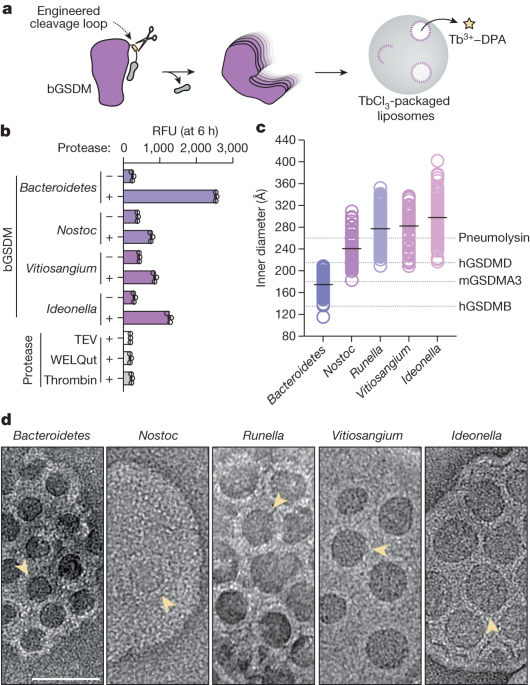Kernekoncepter
Deciphering the mechanism of bacterial gasdermin pore formation reveals diverse pore sizes and an ancient post-translational modification enabling programmed host cell death.
Resumé
The content delves into the structure and assembly of bacterial gasdermin (bGSDM) pores in response to pathogen infection, leading to pyroptosis. Key highlights include:
- Human and mouse GSDM pores consist of 24 to 33 protomers.
- The mechanism and evolutionary origin of membrane targeting and GSDM pore formation are unknown.
- A study on bGSDMs shows diverse pore sizes ranging from mammalian-like assemblies to large pores with over 50 protomers.
- A cryo-electron microscopy structure of a Vitiosangium bGSDM in an active oligomeric conformation is determined.
- Molecular dynamics simulations and cellular assays support a stepwise model of GSDM pore assembly.
Tilpas resumé
Genskriv med AI
Generer citater
Oversæt kilde
Til et andet sprog
Generer mindmap
fra kildeindhold
Besøg kilde
www.nature.com
Structure and assembly of a bacterial gasdermin pore - Nature
Statistik
Studies reveal human and mouse GSDM pores comprise 24 to 33 protomers.
Diverse bGSDMs form distinct pore sizes ranging from smaller mammalian-like assemblies to exceptionally large pores containing more than 50 protomers.
Citater
Vigtigste indsigter udtrukket fra
by Alex G. John... kl. www.nature.com 03-20-2024
https://www.nature.com/articles/s41586-024-07216-3
Dybere Forespørgsler
What implications does the diversity of GSDM pores found in nature have for understanding host-pathogen interactions
The diversity of GSDM pores found in nature has significant implications for understanding host-pathogen interactions. By studying the various sizes and structures of these pores, researchers can gain insights into how different pathogens interact with host cells at a molecular level. Understanding the mechanisms by which GSDM proteins form membrane pores of varying sizes can provide valuable information on how pathogens manipulate host cell death processes like pyroptosis to evade immune responses or cause disease. Additionally, this diversity highlights the adaptability of pathogens in targeting specific cellular pathways through the formation of unique pore assemblies, shedding light on potential strategies for developing targeted therapies against infectious diseases.
How might the discovery of an ancient post-translational modification affecting programmed cell death impact future research in cell biology
The discovery of an ancient post-translational modification affecting programmed cell death could revolutionize future research in cell biology. This finding suggests that covalently bound palmitoyl plays a crucial role in enabling programmed host cell death by facilitating membrane insertion before forming membrane-spanning β-strand regions. Understanding the significance of this modification not only provides new insights into the evolutionary origins of cell death processes but also opens up avenues for exploring novel regulatory mechanisms governing cellular functions beyond pyroptosis. Future studies may focus on elucidating how this post-translational modification influences other cellular pathways and whether it can be targeted therapeutically to modulate cell fate decisions or combat diseases associated with dysregulated cell death.
What potential applications could the knowledge of bGSDM pore assembly mechanisms have in developing novel therapeutic strategies
Knowledge of bGSDM pore assembly mechanisms holds great promise for developing novel therapeutic strategies. By characterizing the structural features and functional properties of bacterial gasdermin (bGSDM) pores, researchers can potentially design targeted interventions to disrupt pathogenic pore formation or enhance immune responses against invading microbes. The ability to engineer bGSDMs with distinct pore sizes offers opportunities to develop tailored approaches for modulating host-pathogen interactions and manipulating cellular outcomes related to pyroptosis. Furthermore, understanding the stepwise model of GSDM pore assembly could inspire innovative drug development efforts aimed at interfering with key stages in pore formation as a strategy to treat infectious diseases or inflammatory conditions linked to aberrant gasdermin-mediated signaling pathways.
0
